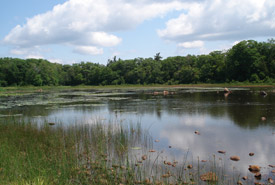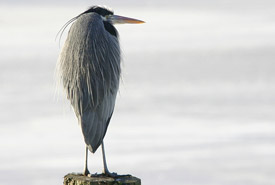Why we celebrate World Wetlands Day on February 2nd

Sandy Island coastal wetland, Ontario (Photo by NCC)
Wetlands have their own day, and rightly so. They are an immense asset for our well-being and safety. Not to mention, they make a great home for all the creatures: plants, animals, amphibians, fish, birds and yes, insects, that live there.
In researching materials for this blog, I decided to go very local. I wanted to see what my town of Rideau Lakes Township is like. For those of you not familiar with Rideau Lakes, it has an area greater than that City of Toronto (807 vs. 630 square kilometres), but a population of slightly more than 10,000. It is bounded by the Rideau Canal to the north, and almost the St. Lawrence Seaway to the south, from Smiths Falls to near the Frontenac. The total shoreline length measures 500 kilometres, excluding the Rideau Waterway. There are 33,000 acres (13,355 hectares) of lake land areas. So yes, we’re wet.
These wetland areas provide habitat for birds, fish and animals while purifying our water. Our safety is involved too — according to the Rideau Valley Conservation Authority, our risk of a severe (100-year) flood is reduced by 10 per cent in Rideau Lakes and the Rideau valley alone thanks to these wetlands.
In Rideau Lakes Township a number of authorities are responsible for safeguarding our wetland areas, including the Rideau Valley Conservation Authority, the Ministry of Natural Resources, Province of Ontario and the township. All, plus others as well, participate in an intricate dance of policy, regulation and observation to make sure these valuable areas are well supported. As our township Manager of Development Services Michael Dwyer explained, “at the local level, we strive to fit the pieces together to protect the greater whole.”
As more and more areas come under official protection, these wetlands will receive the respect and care they deserve. The collaborative efforts to protect the wetlands of Rideau Lakes Township is a success story, perhaps in a more nuts and bolts manner, but strong evidence that policy can lead to healthier wetlands.
In his book Natural Disasters, author Patrick Leon Abbott describes how urbanization has contributed to flood risk, as the natural porosity of soil is permanently sealed over. Humans have lived with flood risk for millennia, however widespread urbanization means that it is now on a much more widespread scale than ever before. Urbanization also contributes to species and habitat loss.

Great blue heron (Photo by Bill Hubick)
Nevertheless, the positive good management of wetlands means that we can reduce or reverse this trend. A wonderful example near where I live is a great blue heron rookery. Now that’s a wild and crazy place in the spring. They are master stalkers of their prey, standing with their long legs in the water, their motionless, spear-like beak poised for the kill. We have a resident heron that visits here regularly. This one literally patrols our beach in search of the small bass, crayfish, and other lovely tidbits he likes.
I say with pride that the wetlands these herons call home have been protected in our area, affording these magnificent birds a place to raise their chicks. With them, and the many other local residents, our daily environment is enriched by their presence.


